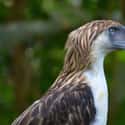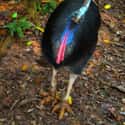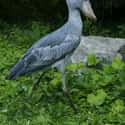-
(#1) Philippine Eagle
- Pithecophaga jefferyi
-
(#2) Kiwi
- Apteryx
The flightless kiwi is part of the family that includes ostriches and emus, despite the fact that it's only the size of a chicken. The kiwi has the largest egg to body size ratio of any bird — it lays an egg that is roughly 6 times the size of a chicken egg.
A male and female kiwi will remain mates for about 20 years, and the male is usually the one who incubates the eggs.
-
(#3) King of Saxony Bird of Paradise
- Pteridophora alberti
-
(#4) Ribbon-tailed Astrapia
- Astrapia mayeri
-
(#6) Golden Pheasant
- Chrysolophus pictus
-
(#7) Sri Lanka Frogmouth
- Batrachostomus moniliger
-
(#8) Kakapo
- Strigops habroptila
-
(#9) Kea
- Nestor notabilis
-
(#10) Blue-footed Booby
- Sula nebouxii
The blue-footed booby obviously gets the first half of its name from its bright blue feet, which it shows off during mating rituals. The second half of its name is thought to come from the Spanish word "bobo," which means "stupid."
There are about a half a dozen species of boobies, and the European settlers probably thought they were all stupid when they saw them bumbling around on land, where they are least graceful.
-
(#11) Magnificent Frigatebird
- Fregata magnificens
-
(#12) Hoatzin
- Ophisthocomus hoazin
The hoatzin is known locally as the "stinkbird" because it smells kind of like manure. This stench is a product of the bird's digestive system, which is more like a cow's than like any other bird's. The hoatzin eats fruits, leaves, and flowers, and those plants are broken down by bacteria in its foregut.
This bird can't fly that well because its huge gut crowds muscles that would be used for flight.
-
(#13) The Atlantic Puffin
The Atlantic puffin looks like a cross between a parrot, a penguin, and a duck. They are actually not closely related to penguins, but instead are part of a separate family of great swimmers and divers called the auks. The Atlantic puffin is often called the "clown of the sea" because of its brightly colored bill. -
(#14) Cassowary
- Casuarius
-
(#15) Andean Cock-of-the-rock
- Rupicola peruvianus
-
(#16) Shoebill
- Balaeniceps rex
-
(#17) Emperor Penguin
- Aptenodytes forsteri
You may have heard the incredible story of the emperor penguin in the 2005 film, March of the Penguins. These penguins lay their eggs in Antarctica, further south than any other species, in the bitter winter. They also defy gender stereotypes — the dads make nests out of their feet and huddle together to keep warm, while the moms go get the food.
-
(#18) Long-wattled Umbrellabird
- Cephalopterus penduliger
-
(#19) Oilbird
- Steatornis caripensis
-
(#20) California Condor
- Gymnogyps californianus
-
(#21) Great Frigate Bird
- Fregata minor
Great frigate birds are capable of staying in flight for up to 56 days, without ever landing. They can do this partly thanks to having the lowest "wing load" (least amount of body weight distributed over the total area of their wings) of all birds.
Frigate birds soar in roller coaster-style loops, making atmospheric energy and weather patterns work for them, instead of flapping like crazy.
-
(#22) Superb Bird of Paradise
- Lophorina superba
-
(#23) Arctic Tern
- Sterna paradisaea
-
(#24) Marabou Stork
- Leptoptilos crumeniferus
New Random Displays Display All By Ranking
About This Tool
Nature is full of all kinds of amazing creatures. This page focuses on those cute and interesting birds in nature. Except for cats and dogs, which are the most popular animals for humans, birds are cute, clever, and interesting, they are also good friends for humans and play an important and interesting role in the ecological balance of nature.
Birds are sensitive to habitat composition and environmental changes, they are important indicator species for the ecological environment and biodiversity. The random tool lists 24 interesting birds on the planet who live in specific areas, many of them are rare and endangered animals.
Our data comes from Ranker, If you want to participate in the ranking of items displayed on this page, please click here.


































